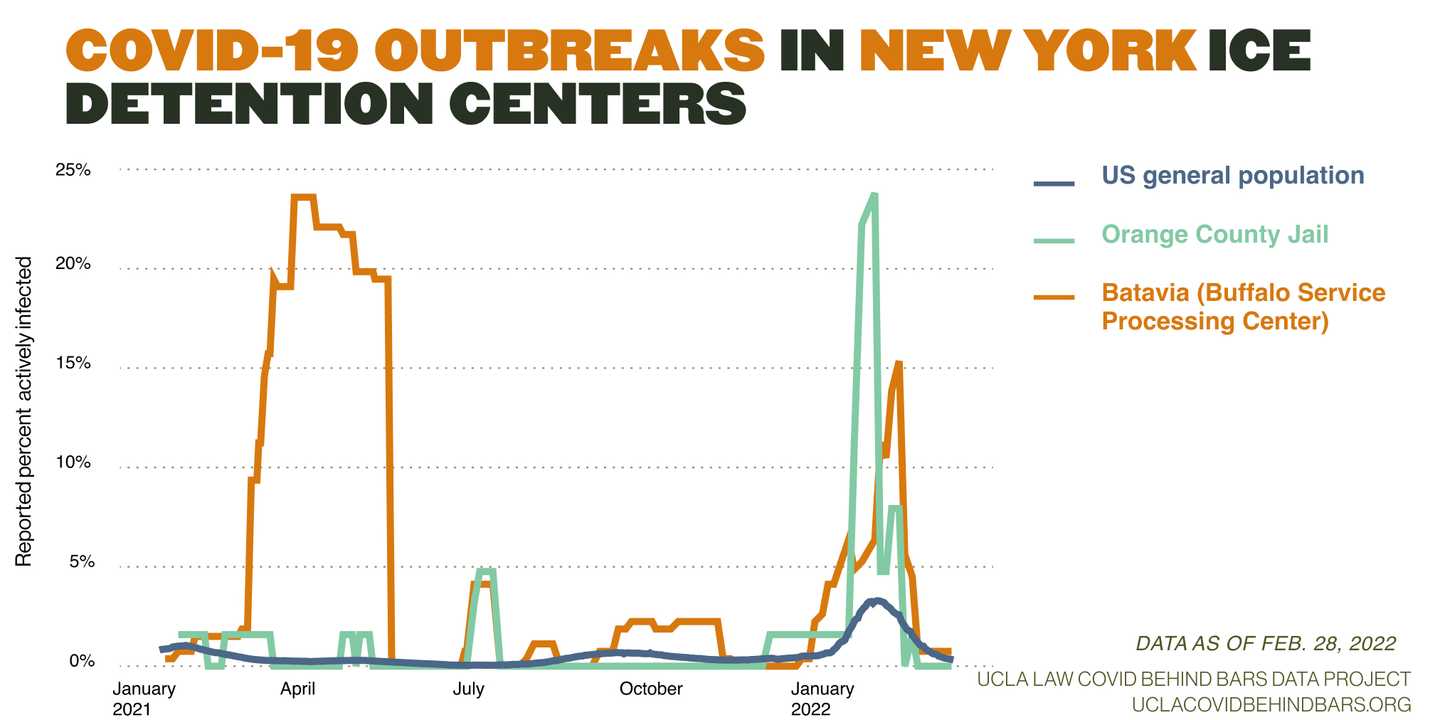March 4th, 2022
Testimony to New York City Council on COVID in ICE Detention Facilities in New York and New Jersey
This week, our staff provided testimony to the New York City Council Committee on Immigration about the crisis of COVID in ICE detention facilities in New York and New Jersey. The text of our testimony is below. A PDF of our testimony is available here.
My name is Hope Johnson, and I am a New York City resident and a data scientist at the UCLA Law COVID Behind Bars Data Project. I have a background in health data analysis and, together with my team of data scientists and health researchers, I’ve spent the past two years tracking the pandemic in prisons, jails, and ICE detention centers across the US. My organization serves as the primary source of data on the pandemic in ICE detention for the Centers for Disease Control, or CDC.
According to data reported by ICE, at least 215 people detained at Buffalo Service Processing Center (Batavia) and at least 28 people detained at Orange County Jail have been infected with COVID since the start of the pandemic. Since the Omicron variant was first detected in the U.S., the number of confirmed cases at Orange County Jail has risen by 75% and at Batavia by 34%.

One outbreak at Batavia, beginning on December 17th 2021, lasted for over two weeks straight. We calculate that there have been at least 80 COVID outbreaks in total at Batavia, and that the facility has been in a state of outbreak for more than a quarter of the entire pandemic.
My colleagues’ research has shown that, even when infection rates in surrounding communities are low, overcrowded conditions inside detention centers create conditions ripe for outbreaks. Despite this and other research showing the epidemiological dangers of overcrowding, detained population levels remained high. ICE has reported that the detained population at Orange County Jail is currently 144, an increase of 80% from where it stood at this time last year. That the population is growing rather than decreasing provides further evidence for ICE’s failures to protect those in its custody.
Public health experts have agreed that releasing people from confinement is the most effective strategy to prevent outbreaks in high risk settings such as ICE detention centers. Although ICE has the discretion to release people, instead they choose to keep individuals detained in overcrowded facilities where social distancing is impossible and infection rates are high.
In addition to high population density, frequent population turnover within ICE detention facilities exacerbates outbreak conditions. In December 2021 alone, more than 30,000 people were newly booked into ICE detention across the US. This problem is only made worse as individuals are transferred around to various facilities while in ICE’s custody. The fact that transfers are used as a means of retaliation goes against public health guidance (a fact that multiple people shared during their oral testimonies on February 28th, 2022) and can have deadly consequences for detained people. No one held in ICE detention was sentenced to death by COVID. This inhumane and unjust treatment of immigrants does not reflect the values we share as New Yorkers.
Throughout the entire pandemic, poor data reporting practices have almost certainly concealed cases and deaths in ICE detention. In October of 2021, my organization rated the data reporting and quality of each correctional agency with a scorecard, and we gave ICE a failing grade. ICE reports no information on vaccinations at all, or infections among staff members, and the only testing information ICE reports is a system-wide total. Although there are people detained in four ICE facilities within New York state, ICE only reports COVID data for two facilities. This information is essential to those public health officials and others who are working hard to bring the pandemic under control, and the refusal to share this data endangers all of us.
Now is the time for New York’s state officials to take resolute steps to gain control over COVID in ICE detention centers. This starts with releasing people rather than detaining and/or transferring them, and providing improved access to health care for those who remain detained. The culture of secrecy and resistance to oversight within ICE detention presents a significant threat to public health and safety.
Thank you very much for providing me with the opportunity to provide testimony on this critically important matter.
Hope Johnson, Data Scientist
UCLA Law COVID Behind Bars Data Project
next post
March 18th, 2022 • Amanda Klonsky, Hope Johnson, and Lauren Woyczynski
Failure to Decarcerate Jails Has Led to Unnecessary Deaths and Widespread Infection During Omicron Surge
Recent data show that, since the Omicron variant first appeared in the U.S., COVID case numbers in local and county jails across the country have increased rapidly, leaving people in jails at high risk of infection and death from the virus once again.